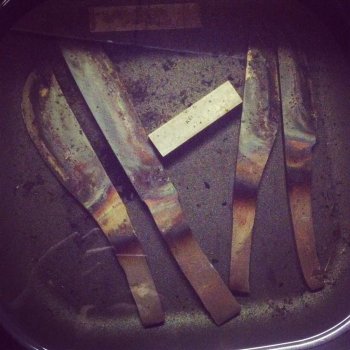You are using an out of date browser. It may not display this or other websites correctly.
You should upgrade or use an alternative browser.
You should upgrade or use an alternative browser.
First hardening cycle
- Thread starter purequill
- Start date
Wayne Bensinger
Well-Known Member
WIP, I love the shape of that first on the left, nice job. Keep the pics coming so we can the progress. One day I'll forge something, first I'll get a forge, lol.
wayne
wayne
Kayakersteve
Well-Known Member
Why do you do multiple hardening cycles?
LRB
Well-Known Member
A common freezer is not cold enough to have any effect on the steel. For any beneficial changes the temp needs to be at or below -100°F, and even then does little to nothing with carbon steels. You did not give any details, so we do not know exactly what you mean in the hardening process, but heat cycling with progressive reducing heats will refine the grain, and will only require one final hardening quench. If you are not giving them a snap temper after the hardening, and before going into the freezer, you are risking cracked blades.
Last edited:
samuraistuart
Well-Known Member
If it is carbon steel, the Mf is around a 100F, or even 200F, so any cooling below that does nothing, even if it is full cryo like LRB mentioned. Steels that are alloyed heavily have Mf's below 0F, and benefit from cryo. And he also mentioned that multiple quenching is not advisable during hardening. One quench is all any steel needs to harden. If grain refinement is what you are after, descending heats after a full normalizing will refine the grain just as well without any risking of micro cracking during the quenching procedure. An air cool is fast enough to refine grain very well without quenching issues.
Kayakersteve
Well-Known Member
Hey guys - Thanks for clarifying - I was certainly confused why more than one hardening cycle was needed.
LRB
Well-Known Member
Hey guys - Thanks for clarifying - I was certainly confused why more than one hardening cycle was needed.
You do realize my last post was sarcasm. Right?
scott.livesey
Dealer - Purveyor
Our goal with the multiple cycles is maximum grain refinement.
is hard to make comments if type of steel and hardening temps are not listed. if you are using high carbon steel, 52100/O1/1095/W2, try one sample using "standard" heat treat, heat to 1475F, when blade is same color as thermocouple, soak for 10 to 20 minutes depending on thickness, quench, temper at 300F for an hour, cold water quench, scrub clean, temper at 325-350F for an hour. heat treat the rest per plan. now you will have a blade to compare the others too.
Thanks Scott! I do indeed plan on trying many different approaches. Those four are all 52100 from the same bearing. I don't know the precise temperature of the heat as I take the edge and bottom third of the blade slightly past non magnetic then quench in 160 deg Texaco Type A. But I will definitely make a test blade and share my findings. As everyone should. It's the only way to learn.
Kayakersteve
Well-Known Member
Actually mine was sarcastic because the answers confused me even more
Steve I'm not too sure either. I believe the first two say in a nutshell that I'm wasting time, I've seen fantastic knives from several people using the method I'm choosing to employ , tested repeatedly to destruction and the last fella is pretty cool suggesting let's make a test blade and treat it "conventionally " and do a side by side comparison.
LRB
Well-Known Member
52100 really requires a controlled soak at quench heat, 1475°, because of it being a pretty highly alloyed steel. Without temp control, you are handicapped from the start. A simple hypoeutectic steel would serve you much better with the apparent limited equipment you seem to have. Without temp control, and more research from other and better sources, you will not get the best out of 52100. Unless of course, you believe you can defy the laws of physics. 52100 is one of the "great" steels, but it has to treated right in order to be so, and what you're doing will not get it there. Yes, the way you are going now, IS a waste of time. If you do not have a good HT oven, you will need one.
samuraistuart
Well-Known Member
"I am following protocols set forth by Ed Fowler"
-"Well that explains it all"
Hilarious! Too funny! Here we ago....yet again.....
-"Well that explains it all"
Hilarious! Too funny! Here we ago....yet again.....
Lol. We aren't "going" anywhere. I'm fully aware of the controversy, especially reading Wick's bio I see he already has some kind of beef. I'm not here to feed into that. I'm here to share what's going on in my shop presently , good bad, whatever. And learn from all of it.
LRB
Well-Known Member
No "beef" at all. Just saying that you're dealing with a steel that you are in no way equipped to handle, and working with misinformation as to what is required to succeed in your quest. Nothing personal involved, just facts that you seem to want to believe can some how be skirted around and ignored, but they can't. Without heat control, you cannot even experiment properly, because you have no way to exactly repeat any beneficial findings you come across. To do any worthwhile and successful experimenting, you will need an oven, or salt system, and a Rockwell tester or access to one. Take care, and good luck.:1:


